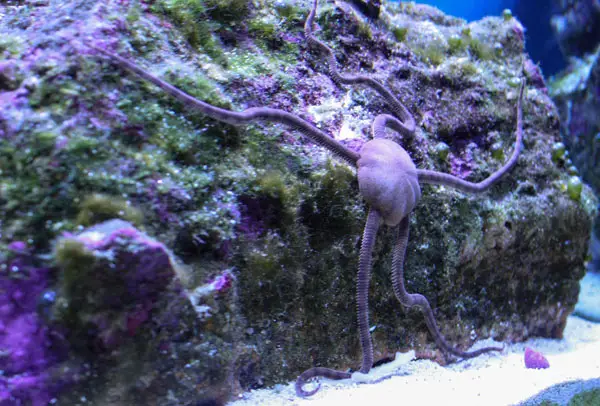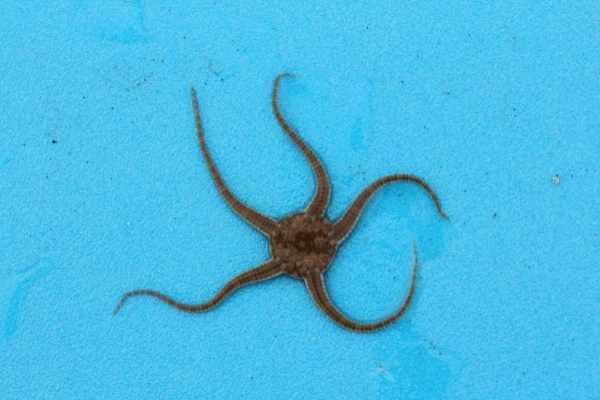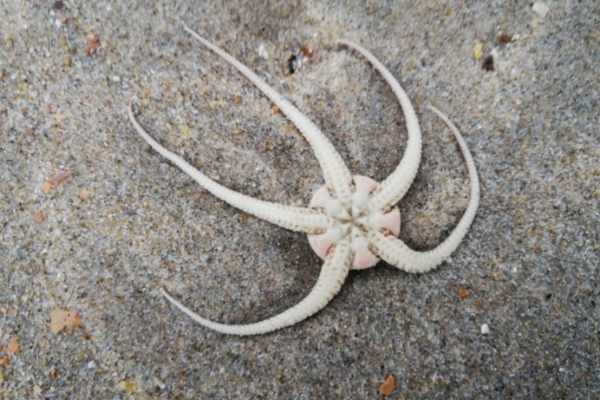When people think of starfish, they call to mind the five-pointed echinoderms you learn to recognize as a kid. So you might overlook serpent starfish at first glance. These brightly colored members of the group trade in those “stubby” arms for long, snake-like limbs. It’s the perfect touch to a saltwater aquarium craving a unique touch. And with top speeds that put the average starfish to shame, you’re sure to impress every visitor that drops by your tank!
Table of Contents: Serpent Starfish
Once you spot a serpent starfish, you’ll want to add one to your tank. They look bizarre, move in ways unlike any other echinoderm out there, and provide beneficial services to any ecosystem they’re a part of – including the saltwater aquarium. You’ll see why as you dive into the links below. If you’re new to keeping serpent stars, you’ll probably want to read through the entire article. They’re relatively easy to care for, but they DO have a few quirks (we’ll cover them). And the last thing you want to do is bring one of these starfish home and find yourself with a problem.
- Serpent Stars vs. Brittle Stars
- Serpent Starfish: Natural Habitat
- Feeding Serpent Starfish
- Reproduction in Serpent Stars
- Serpent Starfish Compatability
- Acclimating Serpent Stars
- For More Information

Serpent Stars vs. Brittle Stars
If you take a look at the Ophiuroidea (one of the five echinoderm families), you’ll find plenty of similar-looking starfish. The group encompasses over TWO THOUSAND species, and they’re found in every marine environment. What links them together are three important features:
- Pentaradial symmetry (This means a body with five symmetrical parts)
- An internal skeleton formed from calcium carbonate
- Tube feet controlled by a water vascular system.
What sets the ophiuroids apart from other echinoderms are those arms. They branch off from a central oral disk and have a long, slender appearance. Usually, they’re flexible and give the starfish a snake-like movement as it moves across the substrate. (That makes sense since “Ophis” is a Greek word meaning snake) And within the family, you’ll see basket stars (the arms branch up and out like tree limbs), brittle stars (the arms possess “bristles” or “spines”), and serpent stars (the arms remain smooth).
All of the species are popular in the aquarium trade for their bright, exotic colors and general hardiness. The unique movement – “rowing” along with two arms at a time – doesn’t hurt, either. And, of course, they have the power of regeneration. Arms that become detached from the central disk CAN regrow – over time. It’s a defensive measure that keeps these echinoderms safe from predators. (And it’s a nifty fact to drop into conversations as people watch your serpent starfish crawl around the rocks)
Serpent Starfish: Natural Habitat
Considering Ophiuriudea comprises THOUSANDS of species, it’s no surprise that you can find serpent stars – well, pretty much anywhere. These unique starfish live in every marine habitat, from tropical reefs to the poles (you read that right – they’ve invaded the Arctic!). They’re adaptable, moving across the sand, coral rubble, and rocks in intertidal zones, over coral reefs, and along seagrass beds. There are even abyssal species living as deep as 20,000 feet (6000m)! (Imagine escorting friends over and saying, “Here’s my 10,000-gallon (37,854L) abyssal biotope tank.”)
Due to their delicate skeleton (those arms may have a skeleton of calcium carbonate ossicles, but they’re on the thin side), most serpent starfish prefer to stay hidden under rocks during the day. Depending on their size, they may also hide out in the branches or coral or the inner chambers of sponges. This habitat offers them protection from the predators seeking to make a meal out of their delicious tube feet (or crunch down on that skeleton). You’ll often see nothing more than an arm or two stretching out from beneath the rocks.
Once night falls, though, they slink out into the open. That’s when they twist and coil their way across the reef in search of food. The tube feet along those arms sweep up zooplankton, detritus, and bits of leftover food, passing it up to their mouths (comprised of FIVE jaws – noticing a theme?). It makes them an important part of the ocean’s clean-up crew. And it also helps reshape the sand along the ocean floor as they sweep those arms around. Without serpent starfish around as engineers, the sediment might lack crucial turning over.
Feeding Serpent Starfish
Serpent starfish are opportunistic scavengers. This means they eat almost anything they find or catch. Those long “snaky” arms? They’re covered with a thin mucus that collects particles of food as the starfish moves along. Then, when they swipe their tube feet along their arm, the feet wipe off any tasty morsels and pass them up to the mouth. You’ll also find additional tube feet around the mouth on that central disk, picking up food when the serpent star settles in place.
And some species HUNT – crawling around and tracking the chemical “scent” of prey with the aid of their tube feet. Then those arms can reach out and wrap around the fish or other invertebrate, pulling toward that Kraken mouth for consumption.
It’s a little different from the digestive system found in other starfish. Serpent starfish can’t extend their stomach or jaws out of their bodies. This is why they’re faster and more mobile than their stubbier cousins. Of course, it’s also less exciting to watch. (Well, unless you happen to catch a glimpse of a serpent star on the prowl)
While serpent starfish DO work well as part of your invertebrate cleaning crew, they may not survive on the detritus and zooplankton available in the tank alone. If you have cleaner shrimp hanging around in your aquarium, you may notice the central disk of your serpent star looking “thin.” This is a sign the echinoderm isn’t getting enough nourishment. You want a “meaty” disk. And if you don’t add supplemental feedings, the starfish may decide to take drastic measures – like eating one of its arms!
Meaty foods work nicely:
- Clams
- Mussels
- Shrimp
- Silversides
At least once a day (or every other day), drop a morsel close to your serpent star’s hiding place. You’ll see an arm slink out to snatch the offering up.
Reproduction in Serpent Stars
Serpent starfish can reproduce in a few different ways:
- Sexual reproduction
- Asexual reproduction with self-fertilization
- Asexual fission
Most species fall into the category of dioecious (separate sexes). Of course, there’s no way to tell males and females apart, and you won’t see successful reports of serpent star breeding in home aquariums. In the wild, pairs release their gametes into the water. The hatched larvae undergo a free-swimming stage as part of the plankton before settling as adults on the seafloor. A few species keep the larvae in pouches inside the central disk, releasing the serpent stars as juveniles.
And then there’s fission. Serpent stars can split their body. They then regenerate the “missing” pieces into a new starfish. (This is similar to their regeneration technique when they “drop” an arm) It’s a form of asexual reproduction.
Can You “Frag” Serpent Starfish?
Fission – and the fact starfish have powerful regeneration abilities – might trigger a lightbulb in your mind. And while this sounds like a feasible method for “fragging” starfish, let’s table the idea. The echinoderm knows what it’s doing when it separates the ossicles. Attempting to split things correctly on your own? That’s a different story. For instance, if the central disk gets separated from the arms, the serpent star will die. That’s not what you want to happen.
And while a single arm separation MIGHT result in a new starfish, you may also end up with the arm reforming on the main animal and nothing else. So it’s not quite the “boom” you’re hoping for.

Serpent Starfish Compatibility
Serpent starfish have a peaceful reputation. They’re nocturnal creatures that prefer to hang out under live rock and coral during the daylight hours. And when they venture out for the evening? They mind their own business as they search for the next meal. That makes them compatible with the majority of popular reef fish:
- Butterflyfish
- Cleaner shrimp
- Clownfish
- Damselfish
- Dwarf angelfish
- Tangs
However, you need to keep in mind that they have that “abandon the arm” tactic for a reason. Plenty of fish and other invertebrates find starfish (ANY starfish) a delicious snack. So unless you want to wake up to a lone, twitching “snake arm” in the morning, you’ll need to skip adding these species as tank mates:
- Arrow crabs
- Boxfish
- Coral banded shrimp
- Harlequin shrimp
- Parrotfish
- Pufferfish
- Triggerfish
And if you want to protect your FISH, you’ll want to skip purchasing the red serpent starfish (Ophioderma squamosissiumus). They bring a pop of crimson to your reef tank, but they also reach impressive sizes. And they LOVE diets of fish and crustaceans. In no time, you’ll find the population in your tank dwindling to…well, not much. If you want to keep this serpent star around, you need to make sure the fish you stock are large enough (or fast enough) to escape.
Acclimating Serpent Stars
While serpent starfish ARE hardy and do well in saltwater aquariums (with standard water parameters), getting them from the store to the tank in the first place is the tricky part. These echinoderms are sensitive to changes in water conditions. Without proper acclimation, you might end up with ill or dead starfish. You also need to AVOID exposing the starfish to air. Even a moment creates shock, leading to the potential of losing legs (or life).
I recommend using the drip method to acclimate a serpent starfish to the conditions in your tank – the same way you would acclimate a shrimp or crab. And since they CAN bring unwanted parasites or protozoans with them, don’t skip the quarantine process.
For More Information
Serpent starfish look strange. And if you’re used to the “standard” starfish, seeing those arms flail around on the sand might startle you. But they’re cool echinoderms to have around. And you won’t find them difficult to manage. If you’re not already convinced, maybe some additional information will help.
Want a crash course on one of the most popular species? This YouTube video will explain everything you need to know about the banded serpent star:
Want to know some of the best tank mates to keep with (non red) serpent starfish?
You don’t always need to purchase serpent stars. They can hitchhike on your live rock!
What has your experience been with serpent starfish? Share it in the comments!


Leave a Reply